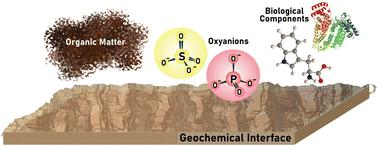当前位置:
X-MOL 学术
›
Environ. Sci.: Processes Impacts
›
论文详情
Our official English website, www.x-mol.net, welcomes your
feedback! (Note: you will need to create a separate account there.)
Analysis of micro- and nanoscale heterogeneities within environmentally relevant thin films containing biological components, oxyanions and minerals using AFM-PTIR spectroscopy
Environmental Science: Processes & Impacts ( IF 4.3 ) Pub Date : 2023-02-01 , DOI: 10.1039/d3em00005b Deborah Kim 1 , Vicki H Grassian 1
Environmental Science: Processes & Impacts ( IF 4.3 ) Pub Date : 2023-02-01 , DOI: 10.1039/d3em00005b Deborah Kim 1 , Vicki H Grassian 1
Affiliation

|
Minerals in groundwater interact with various chemical and biological species including organic matter, proteins, and prevalent oxyanions, resulting in surface coatings and thin films of these different components. Surface interactions and the surface adsorption of these components on both oxide and oxyhydroxide iron surfaces have been widely investigated using a variety of spectroscopic methods. Despite these numerous studies, there still remains uncertainty with respect to interactions between these individual components, as well as heterogeneities and phase segregations within these thin films. In this study, we investigate mixtures containing Fe-containing minerals, proteins, and oxyanions to better understand surface interactions and phase segregation using Atomic Force Microscopy PhotoThermal Infrared (AFM-PTIR) spectroscopy. The results of this study show that AFM-PTIR spectroscopy can identify both nano- and microscale heterogeneities present within these thin films that are difficult to discern with other more conventional techniques such as ATR-FTIR spectroscopy due to phase segregation and mineral surface interactions. Overall, AFM-PTIR spectroscopy provides insights into multi-component environmental films that are difficult to uncover using other methodologies. This method has the potential to differentiate between bound and unbound toxic species as well as biological components, including environmental DNA, which can be used to assess the fate and transport of these species in the environment.
中文翻译:

使用 AFM-PTIR 光谱分析含有生物成分、氧阴离子和矿物质的环境相关薄膜中的微米级和纳米级异质性
地下水中的矿物质与各种化学和生物物质相互作用,包括有机物、蛋白质和普遍存在的氧阴离子,从而形成这些不同成分的表面涂层和薄膜。已经使用各种光谱方法广泛研究了这些组分在氧化物和羟基氧化物铁表面上的表面相互作用和表面吸附。尽管进行了大量研究,但这些单独成分之间的相互作用以及这些薄膜内的异质性和相分离仍然存在不确定性。在这项研究中,我们使用原子力显微镜光热红外 (AFM-PTIR) 光谱研究了含有含铁矿物质、蛋白质和氧阴离子的混合物,以更好地了解表面相互作用和相分离。这项研究的结果表明,AFM-PTIR 光谱法可以识别这些薄膜中存在的纳米级和微米级异质性,由于相分离和矿物表面相互作用,这些异质性很难用其他更传统的技术(例如 ATR-FTIR 光谱仪)识别。总的来说,AFM-PTIR 光谱提供了对使用其他方法难以发现的多组分环境薄膜的洞察力。这种方法有可能区分结合和未结合的有毒物种以及生物成分,包括环境 DNA,可用于评估这些物种在环境中的命运和运输。
更新日期:2023-02-01
中文翻译:

使用 AFM-PTIR 光谱分析含有生物成分、氧阴离子和矿物质的环境相关薄膜中的微米级和纳米级异质性
地下水中的矿物质与各种化学和生物物质相互作用,包括有机物、蛋白质和普遍存在的氧阴离子,从而形成这些不同成分的表面涂层和薄膜。已经使用各种光谱方法广泛研究了这些组分在氧化物和羟基氧化物铁表面上的表面相互作用和表面吸附。尽管进行了大量研究,但这些单独成分之间的相互作用以及这些薄膜内的异质性和相分离仍然存在不确定性。在这项研究中,我们使用原子力显微镜光热红外 (AFM-PTIR) 光谱研究了含有含铁矿物质、蛋白质和氧阴离子的混合物,以更好地了解表面相互作用和相分离。这项研究的结果表明,AFM-PTIR 光谱法可以识别这些薄膜中存在的纳米级和微米级异质性,由于相分离和矿物表面相互作用,这些异质性很难用其他更传统的技术(例如 ATR-FTIR 光谱仪)识别。总的来说,AFM-PTIR 光谱提供了对使用其他方法难以发现的多组分环境薄膜的洞察力。这种方法有可能区分结合和未结合的有毒物种以及生物成分,包括环境 DNA,可用于评估这些物种在环境中的命运和运输。











































 京公网安备 11010802027423号
京公网安备 11010802027423号